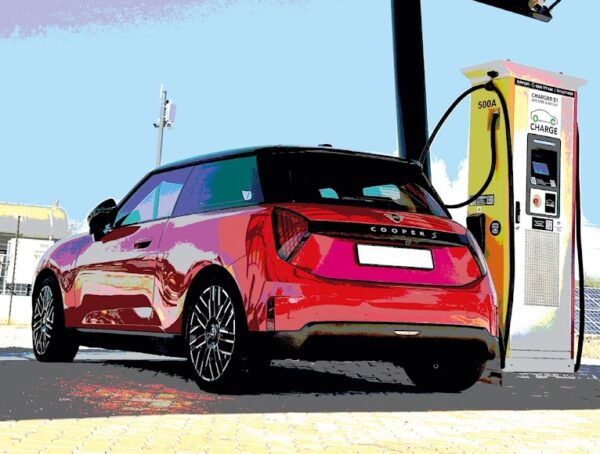Six months ago, I swapped my petrol car for an electric one: the new Mini Cooper SE. This long-term test gave me a perspective on the realities of living with an EV in a country where these cars are largely out of the reach of the average consumer.

While there’s a global trend towards electrification, the local journey is a bumpy one; the cars are expensive and charging infrastructure is sparse. Only 3 543 EVs have been sold in South Africa from 2013 to the end of 2024.
The Mini Cooper SE starts at R802 000 for the base model, but kitted with extras, comes to R924 500. A monthly R159 digital subscription includes navigation with live traffic, augmented reality and 3D buildings; active cruise controls; and AirConsole games, but it has not yet been rolled out in South Africa.
Driving the Mini EV was loads of fun. You can customise the head and taillights, and ask the Mini assistant to, among other things, switch to a radio station, turn on the heated steering wheel, or adjust the temperature. I used my Apple Watch as the primary key, and downloaded overthe- air software updates that brought improved features, such as when you’re charging, it displays the range in realtime. It also allows you up to 18 digital keys for your devices, which you can share with your family.
I live in a house with a wallbox charger that I bought purely because the company offered a media discount, and claimed I was missing out on the full EV ownership experience without one. A home charger means that the Cooper SE’s 49.2kWh battery costs R120.54 to charge, based on my Eskom rate of R2.45 per kWh.
On the GridCars network, charging the 49.2kWh battery on an AC charger at R5.88 per kWh costs more than double that at R289.30, while the DC rate at R7.35 per kWh comes to triple the home charging cost at R361.62.
Slow and steady
In six months, I charged a total of 650kWh, according to the Mini app. The costing looked like this: R1 592.50 at home, R3 822 on an AC charger and R4 777.50 on a DC charger. Running costs differ. You pay per kWh at home, but by speed at public charging stations. If you’re renting or live in a flat and can’t install a charger, you’ll have to rely on public charging points.
The EV driver will also have to contend with loadshedding, offline chargers, or occupied charging bays. I experienced all these scenarios, because I charged everywhere.
Mini offers free charging for the first 12 months when you purchase an EV, and thereafter, it’s R7.06 per kWh at its dealerships.
Cost aside, range can be confusing. After a full charge on the Cooper SE, I once got 270km of range, but another time, 410km.
You learn that range is an estimate based on how efficiently or inefficiently you drove, prior to recharging. This is why Worldwide Harmonised Light Vehicles Test Procedure (WTLP) figures are important because it factors in real-world usage.
Nuances and challenges
I took the Cooper SE on a day trip to the Charge off-grid EV fast-charging station in Wolmaransstad in the North West, and it was an eye-opener.
The trip was 247km from Johannesburg’s northern suburbs, but I used only 100km of range when I reached Wolmaransstad, with 170km left. Most surprising was the leg to Potchefstroom, which netted only 20km of range for the 144km stretch.
Based on flat roads and using Efficient Mode at an average speed of 80km/h, my consumption was at 12.2kWh/100km, which is lower than Mini’s claimed figures of between 14.1–14.7kWh/100km.
I work from home, so I drove a total of 3 437km in six months, which makes the R1 592.50 total cost an average of R265 a month, with a cost per km of 46 cents.
But if we look at the bigger picture, Mini is a luxury EV and at an R802 000, it’s unattainable to the mass market, despite such a low running cost. My long-term test with the Mini Cooper SE showed me the nuances and challenges of navigating South Africa’s evolving EV landscape.
While the driving experience was enjoyable, the tech innovative, and charging costs manageable from home, there are high entry costs, unpredictable infrastructure, and lingering uncertainty about range and reliability. Despite incremental local growth, EVs remain a luxury few South Africans can afford. The Mini Cooper SE underscores both the promise of EVs and the hurdles ahead, and reminded me that widespread electrification in South Africa will depend on significant shifts in pricing, infrastructure, and in the public mindset. Until then, the road ahead remains an exclusive one.
5 DRAWBACKS OF OWNING AN EV
- You can’t be spontaneous in an EV. Road trips require meticulous planning, and any additional stops will require further recharging.
- Time at public chargers; DC chargers usually take 30 minutes from 10%- 80%, but 80%-100% takes the longest, sometimes over an hour.
- Extreme temperatures can reduce performance, and using the heater or air-conditioner drains the battery.
- EVs have some of the worst resale values and can lose up to 50% of their value in the first year.
- High upfront costs. You need to fork out before seeing any returns, despite how little it costs to charge versus fuel costs.
5 ADVANTAGES OF OWNING AN EV
- Low operating costs: EVs cost significantly less per kilometre to operate than ICE cars.
- The convenience of a home wallbox charger means you don’t need to spend time at public chargers. Trickle charging daily works best.
- Software plays a big a part on an EV, which means you benefit from other in-car tech innovations.
- It’s more reliable with fewer mechanical components; maintenance costs or replacement parts are rare. Annual services are a formality.
- Zero tailpipe emissions means reducing air pollution and your carbon footprint, with improved air quality in urban areas.
This article was published in the July issue of Brainstorm magazine: https://brainstorm.itweb.co.za/content/Pero37Z329aMQb6m
Nafisa Akabor
Related posts
ABOUT

Recharged is an independent site that focuses on technology, electric vehicles, and the digital life by Nafisa Akabor. Drawing from her 18-year tech journalism career, expect news, reviews, how-tos, comparisons, and practical uses of tech that are easy to digest. info@recharged.co.za





